W35DC
The W 35 DC has a maximum milling width of only 350 mm but can mill to a maximum depth of 110 mm. This feature makes it an ideal companion of large milling machines, but also enables it to carry out many jobs on its own. The machine goes through every door thanks to its compact dimensions, and its low weight enables it to also work in buildings with low bearing capacity.
-
Repairing small-sized areas
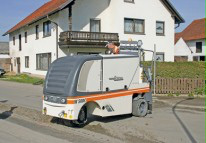
When repairing partial damages in road pavements, the machine operator can control the milling depth, as well as the longitudinal and cross slope of the milled surface with pin-point accuracy. The machine produces a clean, straight and smooth milling edge. The texture of the milled surface permits an excellent bond between the existing base and the new pavement material.
-
Levelling surfaces
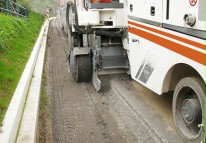
Wheel ruts, pronounced bumps or other kinds of deformation are potential risks to traffic safety. They can be eliminated very quickly by using cold milling machines equipped with specific fine milling drums. This method simply mills off the elevated sections of the road pavement, leaving behind an even and skid-resistant surface that can be used by traffic immediately.
-
Replacing the surface course
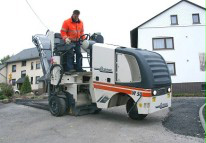
Replacing the surface course at milling depths of up to 4 cm is a typical application in road rehabilitation. In these projects, small milling machines are often used in combination with large milling machines: The small machines work in narrow passages, peripheral areas and around road fixtures, while the large machines mill off the large surfaces.
-
Milling around manhole covers
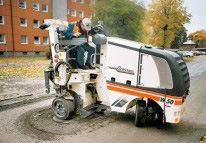
Small milling machines are eminently suitable for removing the pavement around manhole covers at a precisely specified depth, exposing the cover after one single “lap”.
The W 35 DC’s extremely small turning radius and design with one zero side promote this fast and highly precise method that permits milling right up to the edge of road fixtures, eliminating the need for manual reworking.
-
Cutting slots
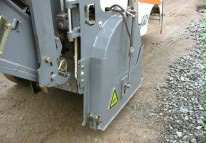
The W 35 DC can be fitted with a narrow slot cutting ring or side cutting ring, enabling it to cut slots along a trench to be excavated. A significantly higher performance can be achieved at significantly lower tool costs when compared to cutting slots with a joint cutter.
-
Milling tie-ins
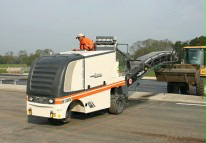
Prior to placing a new pavement, tie-ins to the existing pavement are produced at the beginning and at the end of the newly paved section of road. Milling wedged tie-ins permits a level transition to be produced when placing the new pavement material.
The same applies wherever rehabilitated pavements need to be placed to a specified level, for instance, with water gutters or rainwater inlets.
-
Removing road markings
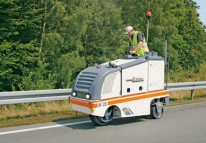
Paint markings or thermoplastic markings can be removed entirely with the W 35 DC. Various special milling drums are available to meet specific quality requirements, offering a narrower tool spacing to produce a fine surface texture, and dual tapered edges to ensure gentle transition from the milled strip to the unmilled surface.
-
Construction of traffic islands
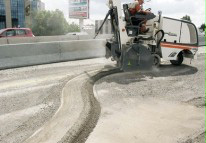
The W 35 DC is capable of milling the asphalt surface at precisely the required depth and in the specified contour for the construction of traffic islands. The exceptionally manoeuvrable 3-wheeled machine enables the design of interesting geometric shapes.
-
Rehabilitating industrial sites
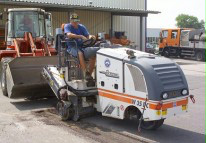
Small milling machines are eminently suitable for the fast removal of asphalt surfaces in or around industrial buildings that are either contaminated or in need of rehabilitation. Special preparations are not required. Milling in layers enables the small milling machine to precisely separate contaminated and non-contaminated material.
-
Rehabilitating indoor pavements

The W 35 DC is ideal for milling indoor concrete pavements, coated surfaces, or screed floors. The machine’s low basic weight enables it to also work on park decks or other indoor surfaces with limited load bearing capacity.
-
Producing expansion joints along rails
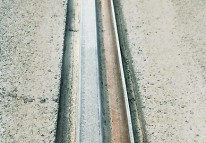
When building new tram lines or rehabilitating the asphalt pavement next to existing rails, the new pavement is placed right up close to the rails. An expansion joint is then required to compensate for the different expansion coefficients of the rails and the road pavement at different temperatures.
A special “rail milling kit” enables the pavement on both sides of the rail to be milled at a fixed depth in one single machine pass.
Fine milling
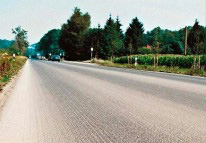
Fine milling drums are fitted with a much larger number of cutting tools than standard milling drums, which results in a much narrower tool spacing. Fine milling produces a very fine surface texture and is carried out at maximum milling depths of just a few millimetres or centimetres.
Typical fine milling applications include:
- Restoring the skid resistance
- Eliminating pavement irregularities
- Preparing surfaces for the application of new, thin pavement layers
- Specific alterations in the cross slope of a road pavement
- Removing coatings
- Removing contaminated pavement layers
Call Today : 403-226-6151
